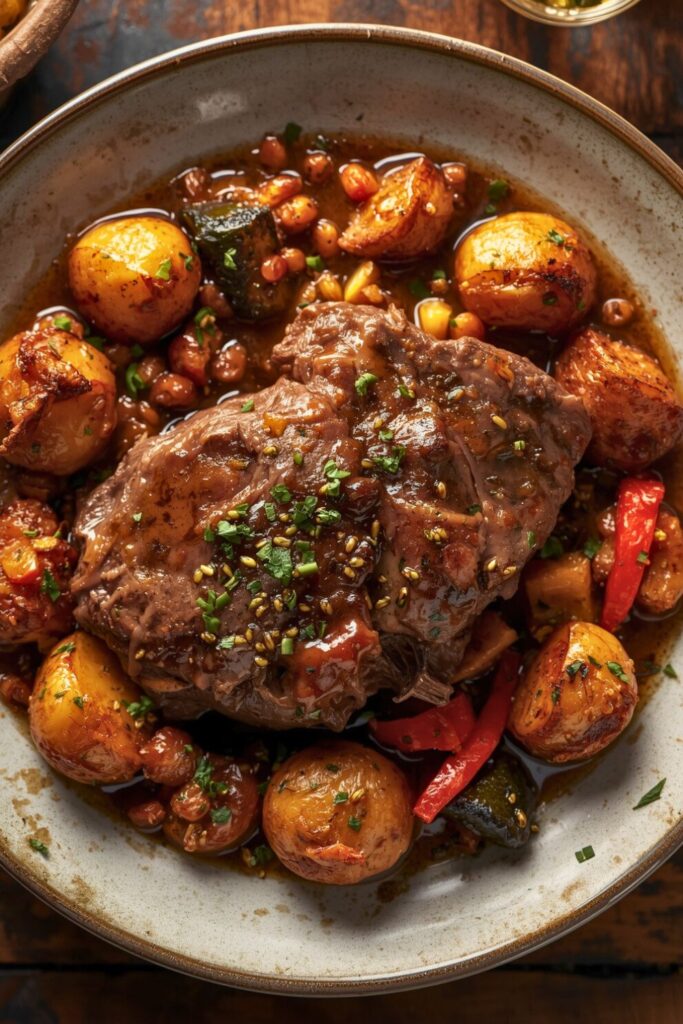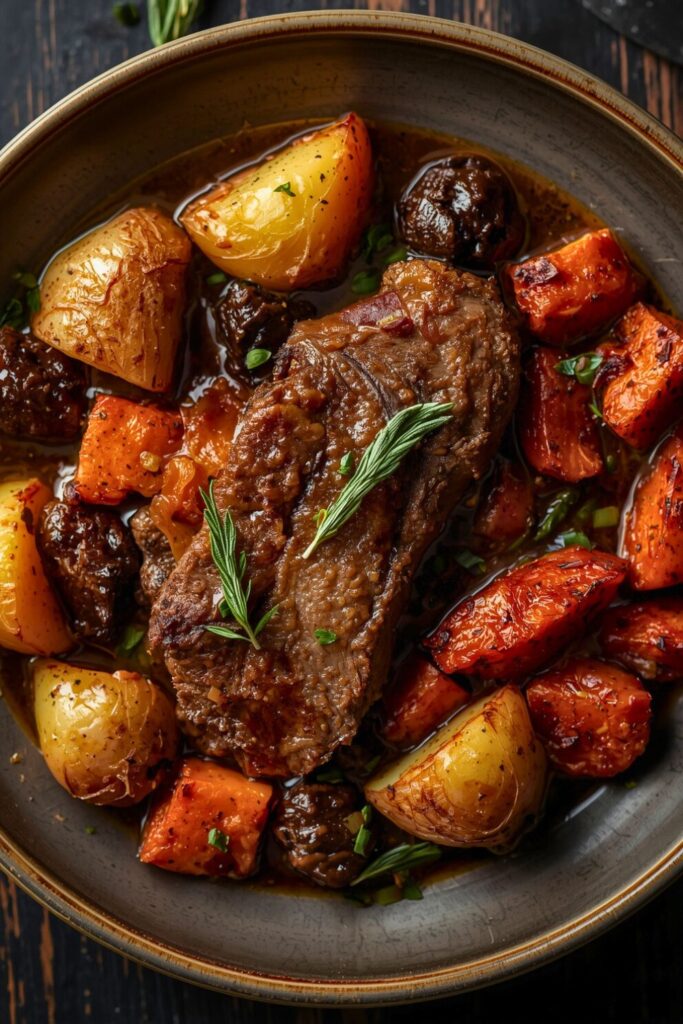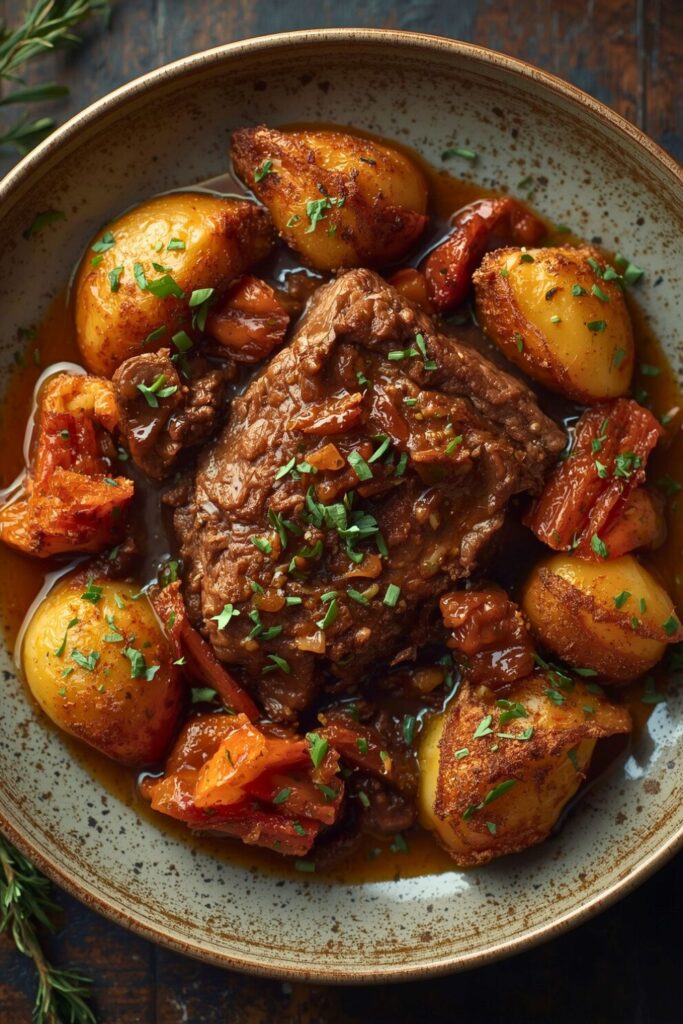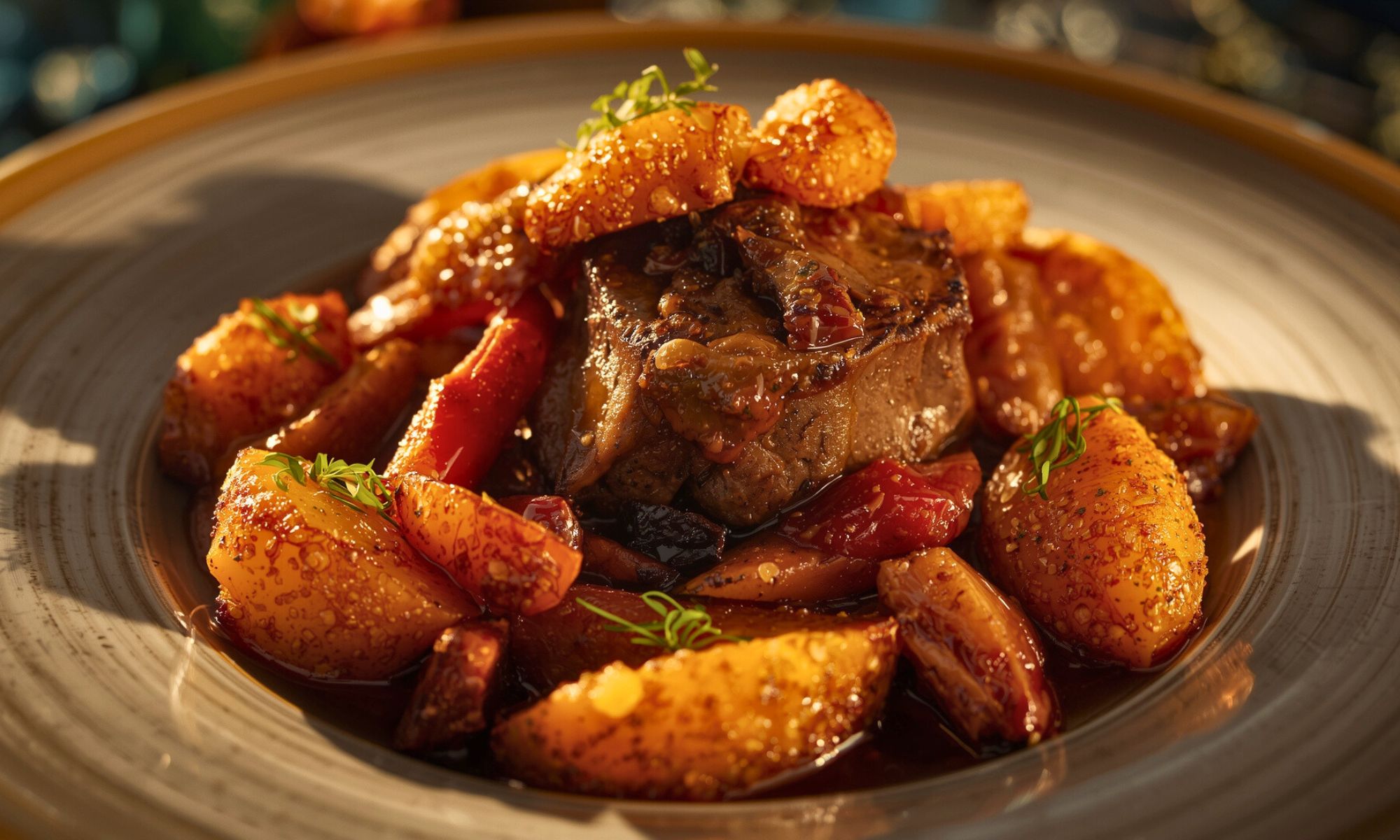Let’s be real: weeknights don’t care about your grocery list or your energy levels. You’re tired, the fridge looks like a graveyard of half forgotten ingredients, and takeout feels like surrender. That’s when Cider Braised Pot Roast With Crispy Sage Potatoes steps in, not fussy, not complicated, just the kind of dinner that proves comfort food can be bold without being boring.
For me, this recipe started on a rainy Sunday with nothing but a chuck roast, a bottle of cider left from the weekend, and potatoes that were begging for attention. Not a cookbook moment, just me, a craving, and the sound of butter sizzling in the pan while sage leaves crackled like little fireworks. I browned the meat, let the cider do its sweet savory magic, and tossed those potatoes in until they promised me a golden crunch.
By the time it hit the table, the roast was fall apart tender, the sauce glossy and rich, and the sage potatoes soaking up every drop while keeping their crispy edge. It wasn’t just dinner, it was that edible version of a hug you didn’t know you needed. And here’s the best part: I’ll walk you through every step, share smart swaps, and give you serving ideas so you can make it yours. Trust me, once you taste this, you’ll be putting it on repeat.
Why This Cider Braised Pot Roast Recipe Changes Everything

The secret lies in the balance of sweet and savory. Apple cider brings natural sugars that caramelize during the long braising process, layering flavors you can’t get any other way. At the same time, slow, gentle cooking breaks down the chuck roast, turning tough cuts into something unbelievably tender and succulent.
But it’s not just about pouring cider into a pot and letting it ride. Technique matters. By building flavor in stages, you create a solid foundation that elevates every bite. And those crispy sage potatoes? They’re not just a side, they’re built to soak up the pan juices while holding onto their golden crunch, giving you the best of both worlds.
The beauty of this dish lies in its versatility. Serve it at a dinner party and watch it impress. Make it for a cozy Sunday meal, and kids will devour the melt in your mouth beef. Even better, leftovers taste richer the next day, making this Cider Braised Pot Roast with Crispy Sage Potatoes a recipe worth repeating.
Essential Ingredients for Perfect Cider Braised Pot Roast
The Must Have Components
For the Pot Roast:
- 3-4 pound chuck roast (look for good marbling)
- 2 cups apple cider (not juice, we want that depth)
- 1 large yellow onion, sliced thick
- 3 carrots, cut into 2 inch pieces
- 3 celery stalks, chunked
- 4 garlic cloves, smashed
- 2 tablespoons tomato paste
- 1 cup beef stock (low sodium)
- 2 bay leaves
- Fresh thyme sprigs
- Salt and black pepper
- 2 tablespoons olive oil
For the Crispy Sage Potatoes:
- 2 pounds small potatoes (fingerlings work perfectly)
- 12-15 fresh sage leaves
- 3 tablespoons butter
- 2 tablespoons olive oil
- Coarse sea salt
Smart Ingredient Swaps That Actually Work
Can’t find apple cider? Mix apple juice with a splash of cider vinegar and you’ll get close—the vinegar adds that subtle tang cider is known for. Still, when it comes to Cider Braised Pot Roast With Crispy Sage Potatoes, nothing quite compares to the depth of real cider.
No chuck roast at the store? A bottom round or brisket will do the job, just give brisket an extra hour or so to break down properly. The key is choosing a cut with enough marbling to stay juicy through the long braise. As for the sage, dried works in a pinch, just use half as much and add it straight to the pot roast instead of crisping it with the potatoes.
And here’s the secret most people overlook: the quality of your cider matters. Skip the overly processed grocery store bottles and grab something unfiltered from a local orchard or farmer’s market if you can. That cloudy, complex cider transforms the flavor and makes this pot roast taste like something truly special.
Choosing the Perfect Chuck Roast
Look for marbling throughout the meat, those white fat streaks mean flavor and tenderness. Avoid lean cuts for this recipe. Fat equals flavor, and we need that richness for proper braising. A good chuck roast should feel firm but give slightly when pressed.
Ask your butcher to tie the roast if it’s not already bound. This keeps everything compact during cooking and ensures even braising. Don’t be shy about asking, they know their stuff and want you to succeed.
Step by Step Mastery of Cider Braised Pot Roast With Crispy Sage Potatoes
Getting Started Right
First things first, take that roast out of the fridge about 30 minutes before cooking. Cold meat hits a hot pan and seizes up immediately. We want it to sear properly, not steam. Room temperature meat browns better and cooks more evenly.
Season that chuck roast generously with salt and pepper. I’m talking really generous here, about a tablespoon of salt total. Big cuts need bold seasoning to penetrate all that meat. Don’t be timid, season like you mean it.
Heat your Dutch oven (or heavy pot with a lid) over medium high heat. Add the olive oil and let it shimmer. This is where patience pays off, if the oil isn’t hot enough, your meat won’t sear properly. You’ll know it’s ready when the oil moves freely across the bottom.
The Searing Secret That Changes Everything
Sear that roast on all sides until it’s deeply browned. We’re talking golden brown, not pale tan. This step creates what’s called the Maillard reaction, basically, it’s where all that incredible beefy flavor develops. Don’t rush this part. It takes about 3-4 minutes per side.
Here’s a common mistake: moving the meat too soon. Let it sit and develop that crust before flipping. If it’s sticking, it’s not ready to turn. The meat will release naturally when properly seared.
Once seared, remove the roast and set it aside. Don’t clean that pan, all those browned bits are liquid gold for flavor. This fond will become the base for your incredible braising liquid.
Building the Ultimate Flavor Foundation
Add your sliced onions to the same pot. They’ll start sizzling immediately in all that leftover fond. Cook them until they’re softened and starting to caramelize, about 5 minutes. This creates sweetness that complements the cider beautifully.
Push the onions to one side and add the tomato paste to the empty space. Let it cook for about a minute until it darkens slightly. This step concentrates the tomato flavor and adds incredible depth. Raw tomato paste tastes harsh, cooked tomato paste tastes like heaven.
Add the garlic and cook just until fragrant, maybe 30 seconds. Burned garlic is bitter garlic, and nobody wants that in their Cider Braised Pot Roast With Crispy Sage Potatoes.
The Braising Magic Begins
Pour in that apple cider and scrape up all those beautiful browned bits from the bottom of the pot. This is called deglazing, and it’s where the magic happens. All that stuck on goodness dissolves into the liquid, creating the base for your braising sauce.
The sizzle when that cold cider hits the hot pan? That’s flavor being born. Use a wooden spoon to really get under those caramelized bits. Don’t leave any behind.
Add the beef stock, bay leaves, and thyme. Nestle that seared roast back into the pot along with the carrots and celery. The liquid should come about halfway up the roast, if it doesn’t, add a bit more stock or cider.
Bring everything to a gentle simmer, then cover and transfer to a 325°F oven. This low, slow cooking is what transforms tough chuck into something incredible. High heat would make the meat tough and stringy.
Timing Is Everything for Perfect Results
Plan on about 3 hours for a 3 pound roast, 3.5-4 hours for a 4 pounder. You’ll know it’s done when you can easily shred it with two forks. The internal temperature should hit 195-205°F, way higher than you’d think, but that’s what breaks down all the connective tissue.
Don’t peek too often. Every time you open that oven, you lose heat and extend cooking time. Trust the process. Your kitchen will smell incredible, and that’s your cue that everything’s working perfectly.
About an hour before the roast is done, it’s time to start those potatoes. This timing ensures everything finishes together for the perfect Cider Braised Pot Roast With Crispy Sage Potatoes experience.
Creating Those Perfect Crispy Sage Potatoes

The Foundation for Crispy Perfection
Wash your potatoes but don’t peel them, that skin is gonna get incredibly crispy and delicious. If you’re using larger potatoes, halve them. For fingerlings, leave them whole. The skin adds texture and holds everything together.
Put the potatoes in a large pot of heavily salted water (it should taste like seawater). This isn’t just for flavor, the salt helps the potato skins set up for maximum crispiness later. Bring to a boil and cook until they’re just tender when pierced with a knife, about 15-20 minutes depending on size.
Here’s the crucial part: drain them really well. I’m talking shake the colander, pat them dry well. Excess moisture is the enemy of crispiness. Some people even let them air dry for a few minutes.
The Crispy Secret Technique
Heat a large skillet over medium high heat. Add the butter and olive oil, the combination gives you the best of both worlds. Butter for flavor, oil to prevent burning. Wait for the butter to stop foaming before adding potatoes.
Once the butter stops foaming, carefully add the potatoes. Don’t overcrowd them, work in batches if needed. Crowded potatoes steam instead of crisp. Let them sit undisturbed for about 4-5 minutes until the bottoms are golden brown.
Flip them carefully (they might stick a bit at first, but they’ll release when ready) and brown the other sides. Patience here pays off with incredible crispiness.
The Sage Finish That Elevates Everything
When the potatoes are golden all over, add those fresh sage leaves to the pan. They’ll sizzle and crisp up in about 30 seconds. The smell is absolutely incredible, nutty, herbal, and completely irresistible.
Watch those sage leaves carefully. They go from perfect to burned quickly. Pull them out as soon as they’re crispy and set aside. These become your garnish for the final Cider Braised Pot Roast With Crispy Sage Potatoes presentation.
Season everything with coarse sea salt while it’s hot. The salt sticks better and you get those little bursts of salinity that make everything taste more intense.
The Science Behind This Perfect Flavor Combination
What we’re doing here is creating contrast in every way possible. The pot roast is soft, rich, and deeply savory. Those potatoes are crispy outside, fluffy inside, with bright herbal notes from the sage. It’s a study in textural harmony.
The apple cider does something really special during that long braise. The natural sugars caramelize, creating this subtle sweetness that balances all the savory elements. The acids in the cider also help break down the meat fibers, making everything more tender. It’s chemistry at work.
That searing step at the beginning? It’s not just for color. When proteins hit high heat, they undergo the Maillard reaction, the same process that makes bread crusts golden and coffee beans aromatic. This creates hundreds of new flavor compounds that simply can’t be achieved any other way.
The braising technique itself is ancient but brilliant. By cooking the meat slowly in liquid at low temperature, we’re essentially turning tough collagen into gelatin. That’s what gives braised meats that silky, luxurious texture that falls apart at the touch of a fork.
Understanding the Temperature Science
Low and slow wins the race here. At 325°F, the meat fibers relax gradually without seizing up. Higher temperatures would make the outside tough while the inside stays raw. Lower temperatures extend cooking time unnecessarily.
The magic happens around 195°F internal temperature. That’s when collagen fully converts to gelatin, creating that melt in your mouth texture that makes people close their eyes when they take a bite.
Professional Presentation for Your Cider Braised Pot Roast With Crispy Sage Potatoes
Plating Like a Restaurant Pro
Let that roast rest for about 10 minutes before slicing. This lets the juices redistribute so they don’t run all over your cutting board. Use this time to get your potatoes perfectly crispy and warm your serving plates.
Slice against the grain, this is crucial for tenderness. Look for the direction of the muscle fibers and cut perpendicular to them. Thick slices showcase the meat better than thin ones. Aim for half inch thickness.
Strain that braising liquid and skim off some of the fat. You can reduce it on the stovetop for a more concentrated sauce, or serve it as is for something more rustic. Both approaches work beautifully.
Arrange those crispy sage potatoes alongside the meat, and spoon some of that incredible braising liquid over everything. The contrast of colors, golden potatoes, rich brown meat, glossy sauce, creates visual appeal that matches the incredible flavors.
Garnishing for Maximum Impact
Those crispy sage leaves you set aside? Now’s their moment to shine. Scatter them over the finished dish for color and aroma. Fresh thyme sprigs add another layer of herbal beauty.
A light sprinkle of coarse sea salt over everything just before serving adds textural interest and makes the flavors pop. Don’t skip this step, it’s the difference between good and great.
Perfect Pairings That Complete the Experience
This dish needs bright acidity to cut richness. Arugula salad with lemon vinaigrette works perfectly. Roasted Brussels sprouts with apple cider vinegar echo the dish’s flavors.
For wine, choose something with body and acidity. Oregon Pinot Noir or dry Riesling complement the apple cider beautifully.
Crusty bread for soaking up pan juices is mandatory. French bread, sourdough, or buttermilk biscuits all work perfectly.
Advanced Tips for Cider Braised Pot Roast Mastery
Make Ahead Magic
This Cider Braised Pot Roast With Crispy Sage Potatoes actually improves overnight. Make the pot roast completely the day before, then gently reheat while you prepare fresh crispy potatoes. The flavors meld and deepen beautifully.
Cool the braised meat in its liquid, then refrigerate everything together. That liquid will gel up (that’s the collagen working), which protects the meat and concentrates flavors even more.
Leftover Innovation
Transform leftover pot roast into incredible sandwiches with horseradish sauce and arugula. Or shred it for tacos with pickled onions and cilantro. The braising liquid makes an incredible base for French onion soup or beef barley soup.
Those leftover crispy potatoes? Reheat them in a hot skillet to restore crispiness, then serve alongside eggs for an amazing breakfast hash.
Seasonal Variations
Fall calls for adding diced apples to the braising liquid for extra apple flavor. Winter benefits from root vegetables like parsnips and turnips. Spring loves fresh herbs like tarragon or chervil instead of thyme.
Summer? Lighten the dish with fresh corn kernels added to the crispy potatoes and bright herbs like basil or mint in the finishing touches.
Bringing It All Together

This Cider Braised Pot Roast With Crispy Sage Potatoes represents everything I love about cooking, it’s technique driven but forgiving, sophisticated but comforting. The kind of dish that makes people linger around your table long after the meal’s finished.
The beauty lies in how each element supports the others. That sweet savory braising liquid, the melt in your mouth meat, those perfectly crispy potatoes with their herbal notes, it all works together to create something truly special. Every bite delivers multiple textures and flavors that keep you coming back.
Here’s my final tip: make extra braising liquid. You can use it as a base for the most incredible gravy, or even freeze it for future braises. Trust me on this one. That liquid is culinary gold.
The best part? This gets even better as leftovers. Those flavors keep developing, and reheated gently, it’s like having a completely new dish the next day. This Cider Braised Pot Roast With Crispy Sage Potatoes keeps giving long after the initial meal.
Cider Braised Pot Roast With Crispy Sage Potatoes: Questions and Answers
Can I make this pot roast in a slow cooker instead?
Absolutely, but you’ll miss some depth from oven braising. Still sear the meat first in a separate pan, don’t skip this crucial step. Use high setting for 4-5 hours or low for 7-8 hours. The liquid won’t reduce as much, so transfer it to a saucepan afterward to concentrate those incredible flavors.
What’s the best way to store and reheat leftovers?
Store the meat and braising liquid together in the fridge for up to 4 days. The liquid will gel up (that’s the collagen working its magic), which actually protects the meat perfectly. Reheat gently in a covered pot over low heat, adding a splash of stock or cider if it seems too thick. Those crispy potatoes taste best fresh, but you can recrisp them in a hot skillet.
My braising liquid seems too thin, how do I fix it?
You’ve got several options here. The easiest is straining the liquid into a saucepan and simmering it down until it reaches your desired consistency. For faster thickening, mix a tablespoon of cornstarch with two tablespoons of cold water, then whisk this slurry into the simmering liquid. Cook for a minute until thickened. Some people mash a few cooked vegetables into the liquid for rustic, natural thickening.
Can I prep any of this ahead of time?
The pot roast actually benefits from being made a day ahead, those flavors really develop overnight in the fridge. Just reheat gently when ready to serve. However, those crispy sage potatoes are definitely best made fresh for maximum crispiness. You can parboil the potatoes earlier in the day and crisp them right before serving. Sage leaves can be fried ahead and stored in an airtight container for a few hours.
What if I can’t find good apple cider locally?
Quality matters, but don’t let perfect be the enemy of good. Grocery store cider works fine, just look for unfiltered varieties with no added sugars. In a pinch, mix apple juice with a tablespoon of apple cider vinegar per cup. The vinegar adds that crucial tang that makes this Cider Braised Pot Roast With Crispy Sage Potatoes so special.

Swiftly Captions by Tina Smith — Quick, flavorful food recipes made simple, bringing fresh inspiration to your kitchen every day






